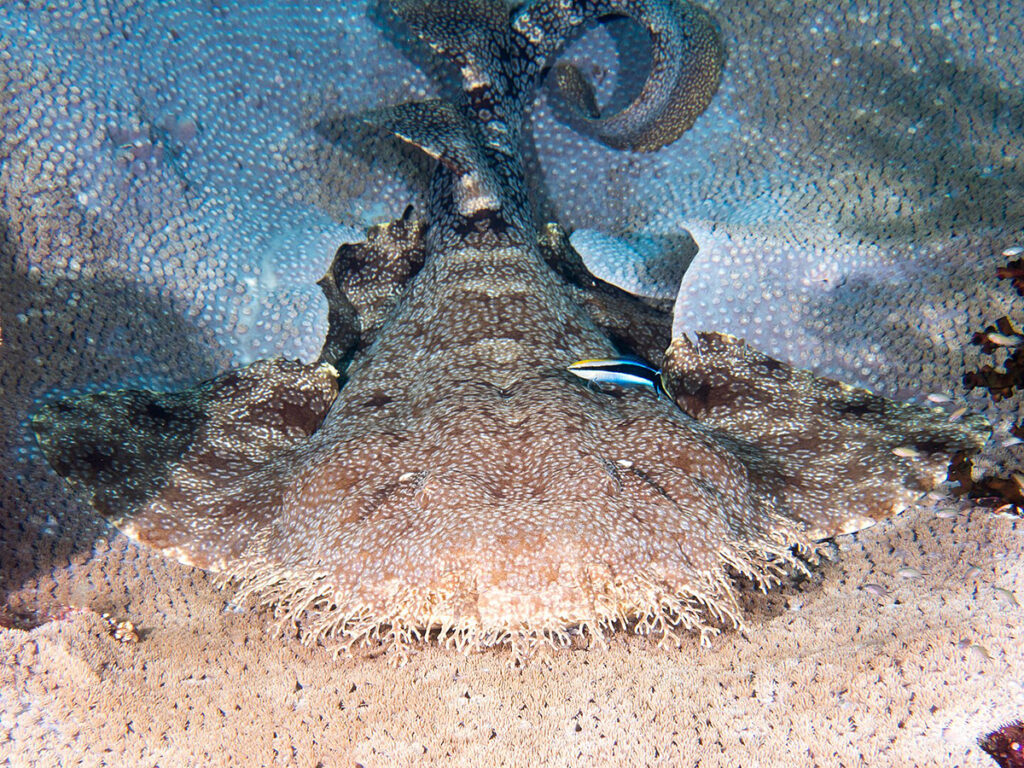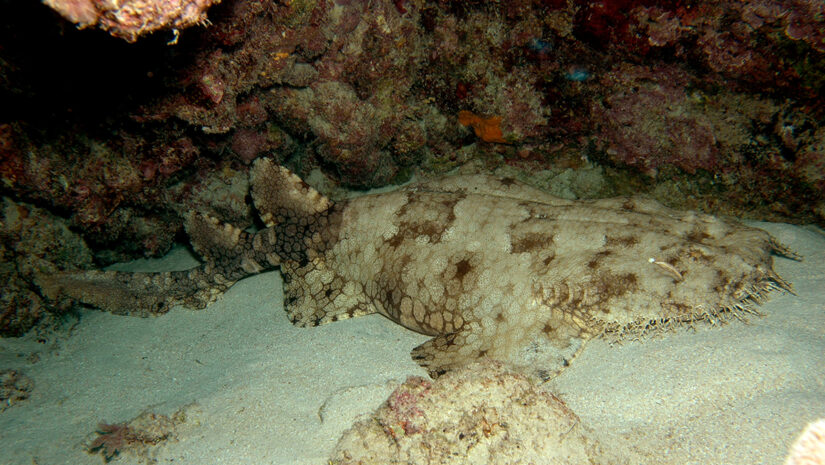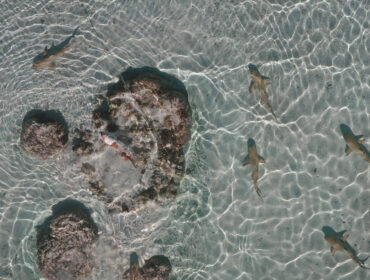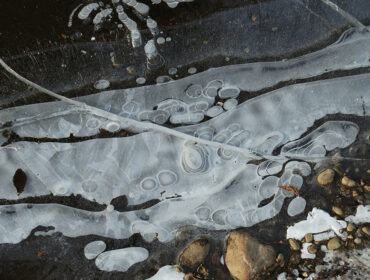Sharks! These apex predators are the icons of the oceans, the kings of the sea, the TRUE ocean masters. Seeing sharks in person is always a breathtaking, humbling experience. According to Smithsonian Ocean, there are over 500 species of sharks out there! Great whites, black-tip reef sharks, makos, and tiger sharks are probably some of the most recognizable. Who hasn’t seen Jaws or its many imitators? But there are so many other super neat sharks out there that deserve the same love and attention! So let’s dive deep beneath the waves to explore some lesser-known shark species. These sharks may be weird, but they are fantastic in their own amazing ways!
Cookiecutter Shark

Talk about a pair of jaws! Cookiecutter sharks are little, cigar-shaped sharks that live in the deep ocean. How did they get that cute-sounding name? Well, these adorably named sharks use their powerful, jointed together jaws to literally take cookie-shaped bites of their prey. According to sharkangels.org, they are the only known shark species to feed this way! Round bites from these sharks have been found on animals such as orcas, dolphins, larger sharks, and other large fish like tuna. Weirdly, bites from cookiecutter sharks have even been reported on underwater sea cables and submarines. Humans are not safe, as divers have reported bites, both on their flesh and on their gear.
Additionally, cookiecutters replace all of their teeth at once!. Because losing 25-30 teeth leads to an extensive energy loss, these kooky sharks can swallow their old batch of teeth to recover the lost calcium. But wait, there is more! Cookiecutter sharks are also able to generate green light on their bellies with the use of photophores. This allows them to camouflage themselves in the sun or moonlight to better hide from predators. Where can you see cookiecutters? It is difficult as they are deep-water sharks. However, sharkangels.org mentions swimmers seeing them in certain channels in the Hawaiian Islands.
Goblin Shark

If you really want a creepy, weird shark, look no further than the goblin shark. Just that face could inspire a horror story. Another denizen of the deep, goblin sharks spend their lives at depths that range from 800ft to 3000ft. Despite the freezing temperatures in which they dwell, goblin sharks can reach some impressive sizes. Males generally reach 8.5 ft, but according to the U.S Fish and Wildlife Service, some specimens have been recorded at 20ft! Let’s be glad goblin sharks don’t interact with humans! So why the weird snout?
Goblin sharks have a higher concentration of ampule of Lorenzini on their noses than most sharks. These are electroreceptors that detect very small changes in electrical fields. In the darkness of the deep ocean, it is handy to be able to detect prey just by the electricity produced by a heartbeat! Also, once prey is detected, the goblin shark activates its truly peculiar feature- its jaws and pointy teeth!
Goblin sharks can swing their whole jawbone forward, significantly increasing their bite range. This happens so fast, it is like a slingshot. Some sources have clocked it at 3.1 meters per second. This is faster than a cobra strike! It is truly worth checking out videos of goblin sharks on YouTube and ocean conservation websites. They are weird and spectacular examples of the diversity contained within our oceans.
Frilled Shark

Rarely encountered in the wild, frilled sharks are yet another resident of our abyssal oceans. They range the deeps worldwide, from tropical to sub-polar regions. These weird, serpentine sharks are more eel-like and primitive in appearance. Many sources call this shark a “living fossil”, as it can trace its lineage back 80 million years. They get their name from having six collar-like pairs of “frilly” gill slits. These lovely weirdos also have sharp, backwards-facing teeth that allow them to grasp and hold onto slithery prey such as squids.
Like other deep-sea sharks, frilled sharks have flexible jaws that allow them to swallow their prey whole. Moreover, what is really weird about frilled sharks is their gestation period. It can be up to 3 and a half years; that is the longest of any vertebrate! Their litters can be 6 to 12 pups, and they are miniature versions of adults. No parenting required here. The young are expected to fend for themselves from birth. So any moms out there: you may have to carry the babies for years, but once they are born, you are done!
Tasselled Wobbegong

Now, here is a weird shark you can visit. Unlike our first three deep-sea weirdos, the tasseled wobbegong prefers shallow habitats near coral reefs. They are often seen around the Great Barrier Reef in Australia. The tasselled wobbegong is a master of disguise. It is part of a special species of sharks known as “carpet sharks”. They are wider and flatter than other sharks. This, combined with their signature “blotchy” coloring, allows them to almost disappear into a reef or the ocean floor. To give them extra camouflage, wobbegong sharks have lobes of flesh that look a little like facial hair. These lobes break up the shark’s outline, allowing them to blend even better with their surroundings.
When they sense prey passing by, wobbegongs lunge out of the water like literal living carpets. They vacuum the poor creature into their mouths and masticate it with needle-like teeth. Additionally, their mouths are so big and their jaws are so stretchy, they can swallow animals as big as other sharks! So, you may be tempted to go search out a tasseled wobbegong on your next dive. Just use caution, as you would any wild animal. They have been known to bite divers who approached too closely.
Greenland Shark

While perhaps not the weirdest-looking shark on this list, the Greenland shark is still a mysterious and unusual species. Parasitic eye worms (yes, that is a thing) are not even the half of it. For one, Greenland sharks are theorized to be the longest-lived vertebrates on the planet. It is possible that Greenland sharks can live 400+ years. Some scientists think there are living Greenland sharks that were alive before Columbus set sail on his fateful voyage.
Greenland sharks don’t even mature fully until around 150 years old! That is a very long adolescence. How do they live so long? There is no one definitive answer. However, their incredibly slow metabolism and very, very cold living conditions probably play a part. Found in the Arctic and North Atlantic, these freezing fish can withstand temperatures to -1 degrees Celsius (30.2 degrees Fahrenheit). There is a weird adaptation that allows for survival in extreme cold. A Greenland shark’s flesh has high concentrations of urea and a neurotoxin called TMAO that acts as a natural antifreeze. But it gets weirder.
Urea and TMAO are very poisonous to humans. People in Iceland and Greenland still consume the flesh. But how? Greenland shark meat is processed by hanging the shark upside down for four to five months. Once this fermentation process is complete, the TMAO neurotoxin is neutralized. Voila! Shark steaks for everyone. Would you go to Greenland to try the flesh of this weird and wonderful shark?
Conclusion
I really hope you were as excited as I was to learn about these lesser-known shark species. Honestly, there are even more out there to be discovered! Remember, these sharks may look weird or creepy or even scary. But they all serve an essential part of our ocean’s ecosystem. Inspiring conservation for all sharks, even the weird ones, is a big part of being an ocean aficionado. Any dedicated SCUBA enthusiast should also be a proponent of ocean conservation, species preservation, and reef health. How else would we make sure there are wobbegongs to visit? Or goblin sharks to marvel at? How else will we keep Greenland sharks around for another 500 years? Our world is weird, wild, and wonderful. Let’s use all of our resources as a community to keep it that way!
Featured Image: By Leonard Low from Australia – Great Barrier Reef, Cairns, Australia, CC BY 2.0, https://commons.wikimedia.org/w/index.php?curid=6517455






